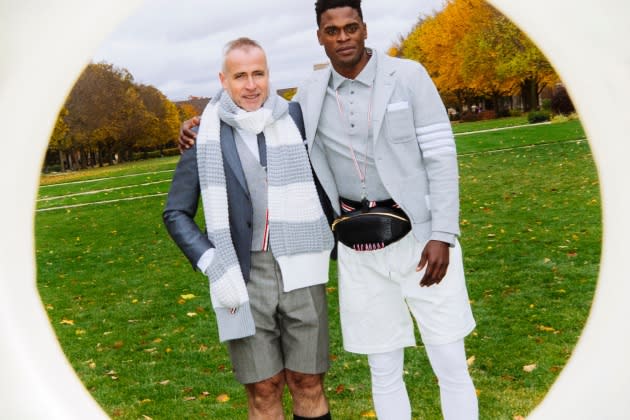Thom Browne Testifies About His Love of Sports in Adidas Trademark Case
- Oops!Something went wrong.Please try again later.

NEW YORK — Thom Browne’s lifelong love of sports — and the long road he traveled to become a successful fashion designer — was center stage on Monday during his testimony in the trademark infringement trial with Adidas centering around the use of stripes.
Browne told his life story to the eight-person jury at Manhattan’s Southern District Court, relating that he grew up in a sports-obsessed household in Allentown, Pennsylvania, with six siblings and was encouraged from a very young age to be active. So he took up swimming and played tennis in high school and continued to swim competitively during his college years at Notre Dame. He still swims but also runs, he said.
More from WWD
Browne graduated with a business degree but rather than going to law school to follow in the footsteps of his attorney parents, he spent several years seeking his own path. He worked at a consulting firm in New York — was a receptionist but got fired because he “hung up on people,” he said — dabbled in film and commercial production and spent five years in Los Angeles doing odd jobs and struggling to survive.
“I was broke,” he said.
It wasn’t until a friend in California created a collection from vintage clothing that a lightbulb went off in Browne’s head. “It was my entry into something I would think about for myself,” he said.
So he sold his car, moved back to New York and got a job working in the Giorgio Armani showroom before Ralph Lauren hired him to be creative director of the iconic American designer’s newly acquired Club Monaco division, which “got me into the design side,” he told the court. That path eventually led Browne to create his own collection in his apartment and launch his own brand in 2003. From the beginning, Browne said, his design aesthetic centered around the blending of tailored clothing with sportswear, or what he referred to countless times during his testimony as “tailored sportswear.”
He said that during his time at Ralph Lauren, he learned the importance of creating an “external signifier” to define his collection. In Browne’s case, he turned to his love of sports and settled on the three stripes that have been pervasive for years in varsity sweaters and other collegiate pieces.
He testified that it was in 2007 that his then-chief executive officer Tom Becker got a call from an in-house attorney at Adidas protesting the three stripes he had been using as a “design choice” on luxury sweatpants, sweatshirts and other products. “Initially, it was frustrating,” Browne told the court, “because my inspiration was from a varsity reference,” but the “last thing I wanted to do was get into a fight with a big company like Adidas.” So he decided to look for an alternative.
After brainstorming with his design team, Browne decided to use four bars because they “looked the best and stayed true to the original inspiration,” he said, which was Ivy League sporting references.
As evidence, his attorney showed sketches from the fall 2008 collection with cardigans sporting three bars next to sketches from the spring 2009 collection showing four parallel bars as an indication of the designer’s willingness to make the change at Adidas’ request.
Not hearing anything else from the German sports brand for 10 years, Browne and his team went on to build the business by adding more product categories, stores and distribution, but always staying true to his original concept — to offer American-inspired fashion that “melded handmade tailoring and sportswear,” he said.
The designer’s legal team handed several items with the four bars to Browne in the witness chair that the designer used to illustrate his distinct designs to the jury. Countless times he referred to the pieces as “tailored sportswear,” whether they were a navy blazer with four tonal stripes on the sleeve or a cashmere hoodie with matching sweatpants.
Browne then testified about the grosgrain ribbon that has now become a trademark of the brand when used as a locker hook on the backs of garments or shoes.
“Every collection and garment I design has a sporting reference,” he said. But the grosgrain red, white and blue locker loop ribbon has become a trademark of the company while the four parallel bars on the garments or the same ribbon running down the leg are instead a “design choice,” Browne said.
In an attempt to distinguish between tailored clothing and sportswear in the collection, Charles Henn, Adidas’ attorney, held up an assortment of the physical product and also used computer images of pieces such as pleated skirts and trench coats and asked Browne to describe them. He answered the same way each time: “tailored sportswear.”
As reported, Adidas and Thom Browne are locked in a battle over whether the designer infringed on the activewear brand’s longstanding trademark for three parallel stripes.
Adidas is seeking $867,225 in damages as well as the $7,011,961 in profits it alleges the fashion designer made from selling apparel and footwear with stripes.
